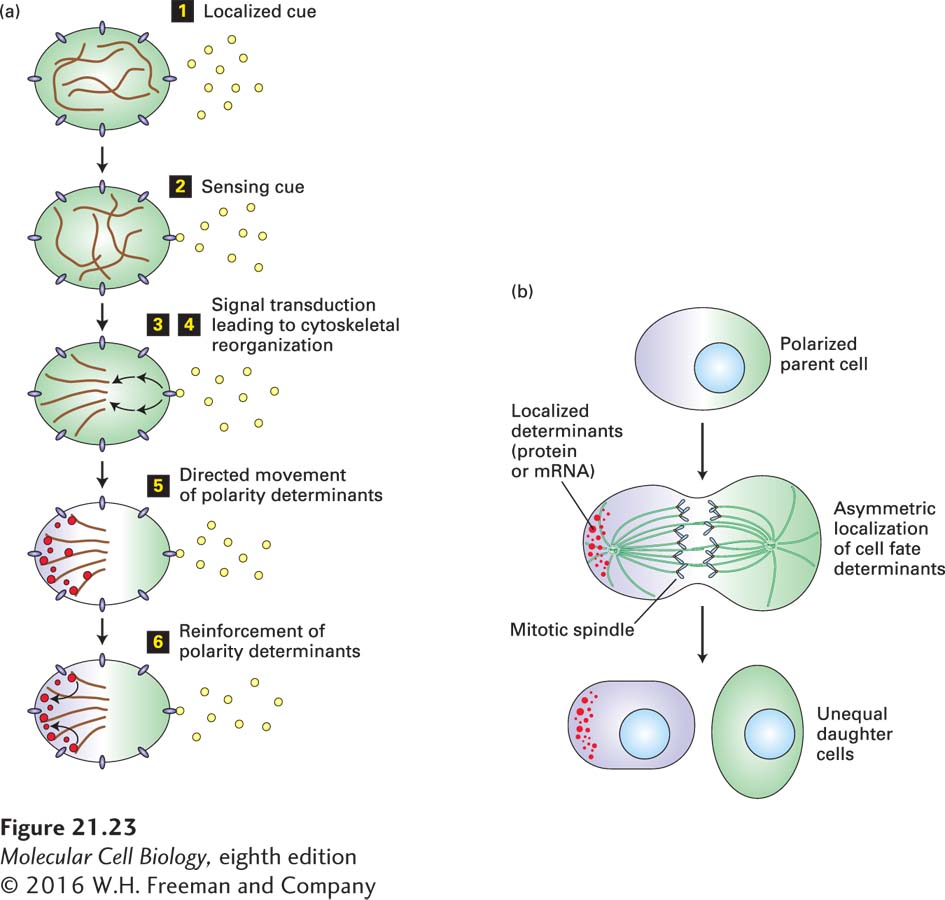Cell Polarization Before Cell Division Follows a Common Hierarchy of Steps
The polarization of a cell, with or without cell division, follows the general pattern diagrammed in Figure 21-23a. In order to know in which direction to polarize, or become asymmetric, a cell generally senses specific cues that provide it with spatial information (step 1). As we will see, such cues can be soluble signals from other cells or from the extracellular matrix. To be receptive to these cues, a cell must have appropriate receptors or other machinery on its surface (step 2). Once the cues have been detected, the cell responds by feeding the incoming signal into its polarity program to define the orientation of polarity (step 3). Generally the next step involves the local reorganization of cytoskeletal elements, notably microfilaments and microtubules (step 4). Once the cell has structural asymmetry, molecular motors direct the trafficking of polarity factors—which, depending on the system, may be cytoplasmic proteins or membrane proteins synthesized by the secretory pathway, or both—to their appropriate locations (step 5). The polarity can often be reinforced or maintained by moving the polarity determinants from sites of lower concentration back to the polarization site to maintain the highest concentration there (step 6).

FIGURE 21-23 General features of cell polarity and asymmetric cell division. (a) General hierarchy of the steps in generating a polarized cell. To know in which orientation to polarize, cells must be exposed to a spatial cue (step 1). They must also have receptors or other mechanisms to sense the cue (step 2). Once a cell senses the cue, signal transduction pathways (step 3) regulate the cytoskeleton (microtubules and/or microfilaments, depending on the system) to reorganize it in the appropriate polarized manner (step 4). The polarized cytoskeleton provides the framework for the transport of membrane-trafficking organelles and macromolecular complexes, including fate and polarity determinants, in the cell (step 5). In many cases, the polarity is reinforced by the return of polarity determinants that have moved away from the site of concentration. In cases in which the determinants are membrane proteins, this reinforcement cycle may involve uptake by endocytosis and delivery to the site of concentration (step 6). (b) Cell polarity requires specific determinants, including mRNAs, proteins, and lipids, to be asymmetrically localized in a cell. If the mitotic spindle is positioned so that these determinants are segregated during cell division, the two daughter cells will have different cell fate determinants. However, if the mitotic spindle is not oriented appropriately, the determinants will not be segregated properly, and the daughter cells could have the same fate (not shown).
If a cell becomes polarized and cell division then occurs in a plane perpendicular to the direction of polarization, the cell has undergone asymmetric cell division. In this way, fate determinants, such as specific proteins or mRNAs, can be differentially segregated between the cells (Figure 21-23b).
Cell polarization can be a very dynamic process. Consider a macrophage chasing a bacterium in order to catch and destroy it by phagocytosis: the macrophage must continually sense the bacterium, which it does by following a gradient of a peptide left by the bacterium (see Figure 17-46). This signal orients—or polarizes—the macrophage to move in the correct direction. This example highlights an important and common aspect of cell polarity: in many cases, it must be dynamic so that, as in the example of the macrophage, it can quickly change direction. Although we have illustrated the dynamics of cell polarity in terms of a macrophage, the polarity of epithelial and other cells that appear very static are probably quite dynamic when those cells are moved to different environments.
In the next section, we discuss a simple cell that shows asymmetry: a yeast cell responding to a soluble cue during mating. In later sections, we turn to animal cells, in which conserved polarity proteins are instrumental in interpreting polarity cues and generating cell asymmetry prior to cell division. We then describe how these same polarity proteins are used to polarize epithelial cells. Finally, we discuss aspects of asymmetric division in stem cells.
